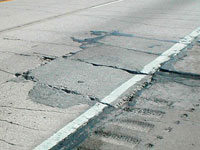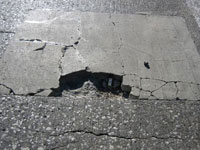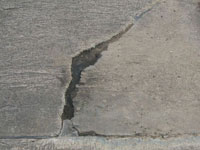It’s easy enough to fix a pothole, but how easy is it to actually prevent them from appearing at all? Given the number of cracks and potholes that plague Texas roadways, there is no question about the value that a successful preventive maintenance could have in delaying more serious problems.
Various methods exist to identify distresses in concrete and asphalt concrete overlaid pavement, and simple patching is usually a good temporary fix. But less-experienced engineers may miss the signs of early serious structural damage to the pavement because of a lack of experience or a decision-making process based only on visual distress surveys.
“By the time a visual inspection shows distress, it’s time for a major overhaul,” says Texas Transportation Institute’s (TTI‘s) Tom Freeman, engineering research associate. “In this project, we collected the last 30 years of field experience and developed tools that engineers can fit in their pockets.”
The research team developed a pocket field manual, a field survey and field guidelines. As engineers retire from TxDOT, too often their expertise goes with them. Freeman’s work has captured some of that corporate knowledge, making the maintenance process more efficient overall.
The field manual provides a standard for maintenance crews to use in determining and describing the problems they may encounter; it also includes pictures, possible causes and recommended lab tests. The team also used a survey to evaluate the effectiveness of full-depth repair, various joint repair techniques, joint resealing and dowel bar retrofit with diamond grinding.
The guidelines include non-destructive test procedures for subsurface layers, such as the falling weight deflectometer and ground penetrating radar (a technique developed at TTI). The guidelines also provide discussion on each maintenance stage, promoting the best standard practices and specifications used by state departments of transportation across the country. A step-by-step repair method and decision-making process gives engineers the options of preventative maintenance, functional or structural concrete pavement repair or full resurfacing.
“Routine maintenance at the right time can extend pavement life in a cost-effective manner,” says Freeman. “It takes longer to repair a section of very poor pavement, while with the same amount of resources, an agency can maintain far more sections of pavement in good and fair condition.”
These tools are timely since there is a renewed federal interest in improving transportation infrastructure, which is good news to state departments of transportation. Freeman’s next project will work with TxDOT to develop a class that will teach engineers around the state the decision-making processes found in these products.
“This research defines another set of tools for TxDOT engineers to economically maintain pavements on an aging transportation system with decreasing funding,” says TxDOT‘s Paul Montgomery, director of maintenance. “These tools help us along the path of progress in pavement management.”




The pocket field manual, field survey and field guidelines developed by TTI researchers will aid maintenance crews in identifying concrete distresses like the ones shown above.
